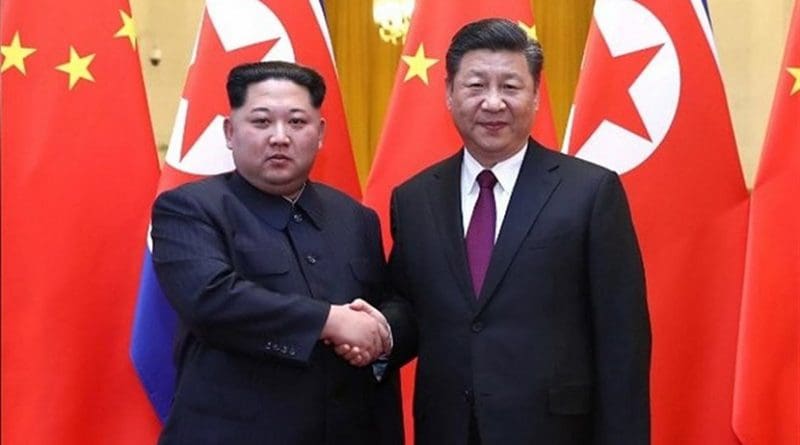The Trump-Kim Summit: Geopolitical And Economic Implications For China – Analysis
By IPCS
By Ayan Tewari*
The 12 June 2018 summit meeting between US President Donald Trump and North Korea’s Supreme Leader Kim Jong-un in Singapore has seemingly begun the process easing of relations between North Korea and the US, and by extension, the West. If the efforts are followed through, it could result in decisively shifting the focus of tensions from East Asia to the South China Sea (SCS).
This meeting has also seemingly triggered steps towards reduced sanctions on North Korea, as well as the US’ tacit approval of the regime (similar to authoritarian regimes in Central Asian or West Asia). If economic and political stability arrives in North Korea, it could reduce the odds of potential crises in North Korea spilling into China (such as in the 1990s when approximately 250,000 refugees seeking food led to significant disturbances in China’s north east). However, if North Korea’s exit from isolation follows the 1980s Chinese or Vietnamese model, Beijing will have a major competitor for production. Furthermore, a Sino-North Korean split is also a bleak, yet plausible long term consequence, resulting in the removal of China’s strategic buffer.
For China, there are tactical gains and strategic losses involved. China’s view of stability in the Korean Peninsula is a fine balancing act: i.e. Pyongyang should pose enough of a threat to keep Beijing’s regional competitors preoccupied without allowing the pot to boil over. North Korea’s sudden spurt of missile and nuclear tests combined with bellicose statements were, in China’s opinion, allowing the pot to boil over. To address this, China had developed a contingency plan called Kim Jong-nam—Kim Jong-Un’s exiled elder half-brother, intended to be used as leverage to ensure North Korean compliance. However, Kim Jong-Nam’s assassination nulled this leverage; and the lack of leverage, combined with the North Korea-US thaw, means a mixed bag for China.
China has for long expressed significant concern regarding US joint military exercises and equipment in close proximity to its own territory. If these drills come to an end, China will face less pressure from its east, even more so due to Trump’s promise of withdrawing all US troops from South Korea. Moreover, Washington has used the Pyongyang threat as an excuse to increase its security related presence in the region. If North Korea gradually ceases to be a threat, the US’ involvement in East Asia will almost certainly reduce. For example, the deployment of the Terminal High Altitude Area Defence missile defence system in the Korean Peninsula, which blunted Chinese deterrence against the US but which the US claimed was solely aimed at North Korea, can no longer be justified. This would significantly ease Chinese tactical concerns in the region. This will also enable China to refocus its military efforts elsewhere. For Beijing, this is the net positive.
Nevertheless, reduction of the North Korea threat to the US means the latter and its allies would also refocus their attention on the SCS region. The US has already begun undertaking concrete steps in this regard. For instance, China was disinvited from the 2018 iteration of the 26-country Rim of the Pacific (RIMPAC) naval exercise. Additionally, the US’ force levels in Japan, the primary strategic location to contest China vis-à-vis the SCS, remain static. In addition to China, US forces in Japan will keep an eye on North Korea from a safe distance.
Moreover, as and when North Korea’s isolation reduces (and eventually, ends), Western corporations will have the opportunity to shift production to North Korea. While this would be a slow transition, companies might take advantage of the low wages and state control over labour. Given how employment in sectors other than agriculture is currently highly limited, an opening up of the North Korean economy could result in significantly greater employment in sectors other than agriculture. Nonetheless, this might not automatically bring about improved labour conditions overnight. Increased incentivisation of North Korea combined with ‘lucrative’ labour conditions and a skilled workforce may lead to the shifting of some investment from China to North Korea.
It is also important to mention, however improbable, a potential North Korea-China split. The Sino-Soviet split too was borne of similar circumstances: a previously isolationist state rejecting hegemony and fostering relations with their primary economic and geopolitical rival, the US.
To conclude, although China’s strategic buffer might operate as planned in the short run, its ‘strategic distraction’ function may slowly erode, resulting in the US’ attention getting refocused to Beijing’s expansion in the SCS. Furthermore, if the West manages to open up North Korea’s markets to foreign direct investment, rising wages in Chinese factories may have to compete with a disciplined, cheaper workforce in North Korea. Through this, the North Korean regime could be enveloped in the Western sphere of influence.
It remains to be seen if China will accept the negatives as it clearly has significant incentives to scupper any meaningful peace in the Korean Peninsula.
*Ayan Tewari
Research Intern, Centre for Internal and Regional Security (IReS)

